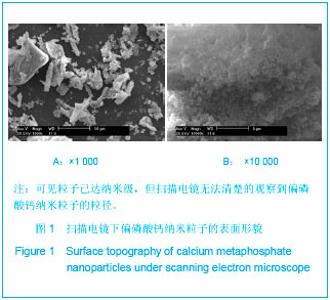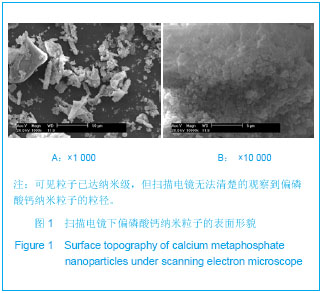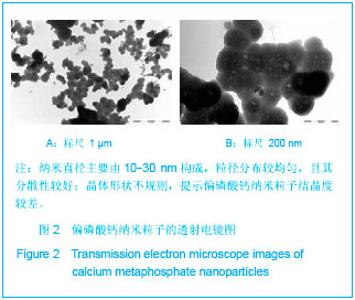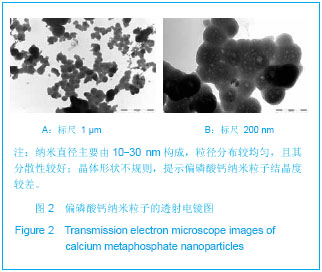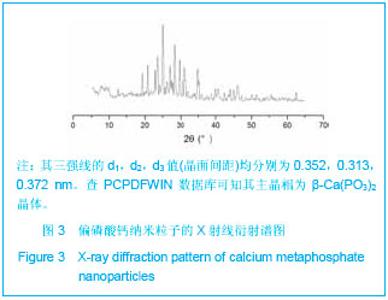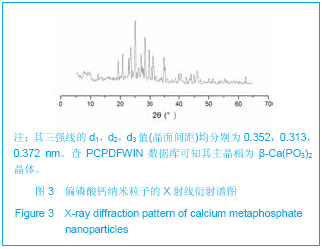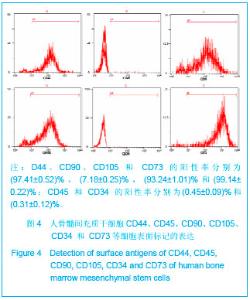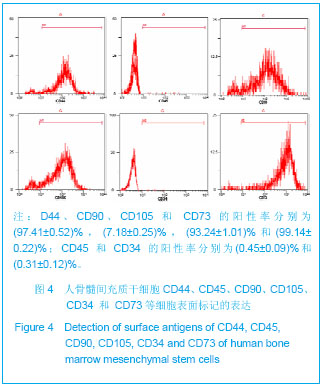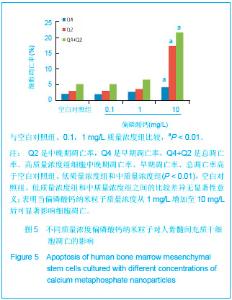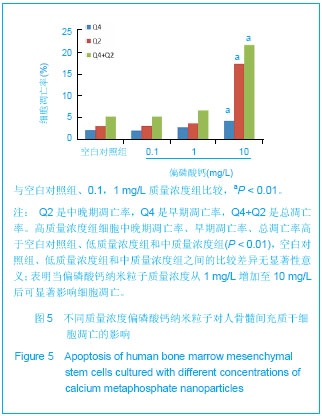Chinese Journal of Tissue Engineering Research
Previous Articles Next Articles
Cytocompatibility of calcium metaphosphate nanoparticles
Wu Yue-heng1, Mai Li-ping1, Chen Peng2, Zhang Ling-min2, Huang Huan-lei1, Zeng Xiang-jun1, Tang Shun-qing2, Xiao Xue-jun1, Yu Xi-yong1
- 1Medical Research Center of Guangdong General Hospital, Guangdong Provincial Cardiovascular Institute, Guangdong Academy of Medical Science, Guangzhou 510100, Guangdong Province, China; 2Institute of Biomedical Engineering, Jinan University, Guangzhou 510632, Guangdong Province, China
-
Received:2013-01-22Revised:2013-06-25Online:2013-09-17Published:2013-09-17 -
Contact:Yu Xi-yong, Professor, Doctoral supervisor, Medical Research Center of Guangdong General Hospital, Guangdong Provincial Cardiovascular Institute, Guangdong Academy of Medical Science, Guangzhou 510100, Guangdong Province, China yuxycn@hotmail.com -
About author:Wu Yue-heng★, Master, Assistant researcher, Medical Research Center of Guangdong General Hospital, Guangdong Provincial Cardiovascular Institute, Guangdong Academy of Medical Science, Guangzhou 510100, Guangdong Province, China edgar_wu@yahoo.com.cn -
Supported by:the National Natural Science Foundation of China, No. 30901468*
CLC Number:
Cite this article
Wu Yue-heng1, Mai Li-ping1, Chen Peng2, Zhang Ling-min, Huang Huan-lei, Zeng Xiang-jun,Tang Shun-qing, Xiao Xue-jun, Yu Xi-yong. Cytocompatibility of calcium metaphosphate nanoparticles[J]. Chinese Journal of Tissue Engineering Research, doi: 10.3969/j.issn.2095-4344.2013.38.015.
share this article
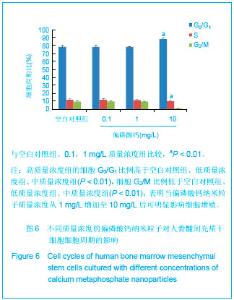
对图5的数据进行方差分析发现,高、中、低质量浓度组及空白对照组间的细胞中晚期凋亡率、早期凋亡率和总凋亡率的比较差异有显著性意义(P < 0.01)。进一步采用S-N-K检验对高、中、低质量浓度组及空白对照组之间分别进行两两比较,结果发现高质量浓度组细胞中晚期凋亡率、早期凋亡率和总凋亡率与空白对照组、低质量浓度组和中质量浓度组之间的比较差异有显著性意义(P < 0.01),空白对照组、低质量浓度组和中质量浓度组之间比较差异无显著性意义。 图6是人骨髓间充质干细胞分别在含高(10 mg/L)、中(1 mg/L) 和低(0.1 mg/L)质量浓度偏磷酸钙纳米粒子的培养基中培养7 d后,细胞周期的测量结果。对图6的数据进行方差分析发现,高、中、低质量浓度组及空白对照组的细胞G0/G1和G2/M期比例比较差异有显著性意义(P < 0.01),高、中、低质量浓度组及空白对照组细胞S期比例的比较差异无显著性意义(P=0.503)。进一步采用S-N-K检验对高、中、低质量浓度组及空白对照组之间细胞G0/G1、G2/M期的比例分别进行两两比较,结果发现,高质量浓度组与空白对照组、低质量浓度组、中质量浓度组之间的细胞G0/G1比例比较差异有显著性意义(P < 0.01),空白对照组、低质量浓度组和中质量浓度组两两之间的G0/G1比例比较差异无显著性意义。高质量浓度组细胞G2/M比例与空白对照组、低质量浓度组、中质量浓度组比较差异有显著性意义(P < 0.01),空白对照组、低质量浓度组和中质量浓度组两两之间的细胞G2/M比例比较差异无显著性意义。"
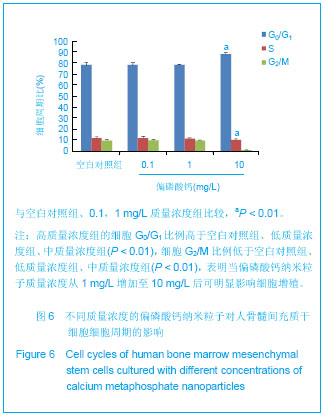
| [1] Malvindi MA,Brunetti V,Vecchio G,et al.SiO2 nanoparticles biocompatibility and their potential for gene delivery and silencing. Nanoscale.2012;4(2):486-495. [2] Biradar S,Ravichandran P,Gopikrishnan R,et al.Calcium carbonate nanoparticles: synthesis, characterization and biocompatibility.J Nanosci Nanotechnol 2011;11(8): 6868-6874. [3] Tang F,Li L,Chen D.Mesoporous silica nanoparticles: synthesis, biocompatibility and drug delivery.Adv Mater.2012; 24(12):1504-1534. [4] Alarcon EI,Udekwu K,Skog M,et al.The biocompatibility and antibacterial properties of collagen-stabilized,photochemically prepared silver nanoparticles. Biomaterials.2012; 33(19): 4947-4956. [5] Huang X,Zhuang J,Teng X,et al.The promotion of human malignant melanoma growth by mesoporous silica nanoparticles through decreased reactive oxygen species. Biomaterials.2010;31(24):6142-6153. [6] Singh S,Dosani T,Karakoti AS,et al.A phosphate-dependent shift in redox state of cerium oxide nanoparticles and its effects on catalytic properties. Biomaterials.2011;32(28): 6745-6753. [7] Ladewig K,Niebert M,Xu ZP,et al.Efficient siRNA delivery to mammalian cells using layered double hydroxide nanoparticles. Biomaterials.2010;31(7): 821-1829. [8] Labouta HI,Schneider M.Interaction of inorganic nanoparticles with the skin barrier: current status and critical review.Nanomedicine.2013 ;9(1):39-54. [9] Fan K,Cao C,Pan Y,et al.Magnetoferritin nanoparticles for targeting and visualizing tumour tissues.Nat Nanotechnol. 2012;7(7):459-464. [10] Huang HC,Barua S,Sharma G,et al.Inorganic nanoparticles for cancer imaging and therapy.J Control Release.2011; 155(3):344-357. [11] Son SJ,Bai X,Lee SB.Inorganic hollow nanoparticles and nanotubes in nanomedicine Part 1. Drug/gene delivery applications.Drug Discov Today. 2007;12(15-16):650-656. [12] Geidel C,Schmachtel S,Riedinger A,et al.A general synthetic approach for obtaining cationic and anionic inorganic nanoparticles via encapsulation in amphiphilic copolymers. Small.2011;7(20):2929-2934. [13] Pittella F,Zhang M,Lee Y,et al.Enhanced endosomal escape of siRNA-incorporating hybrid nanoparticles from calcium phosphate and PEG-block charge-conversional polymer for efficient gene knockdown with negligible cytotoxicity. Biomaterials.2011;32(11):3106-3114. [14] Yang X,Walboomers XF,van den Dolder J,et al.Non-viral bone morphogenetic protein 2 transfection of rat dental pulp stem cells using calcium phosphate nanoparticles as carriers. Tissue Eng Part A.2008;14(1):71-81. [15] Park EK,Lee YE,Choi JY,et al.Cellular biocompatibility and stimulatory effects of calcium metaphosphate on osteoblastic differentiation of human bone marrow-derived stromal cells.Biomaterials.2004;25(17):3403-3411. [16] Lee YM,Seol YJ,Lim YT,et al.Tissue-engineered growth of bone by marrow cell transplantation using porous calcium metaphosphate matrices.J Biomed Mater Res.2001;54(2) : 216-223. [17] Cho IH,Lee JH,Song YG,et al.Evaluation on the efficacy and safety of calcium metaphosphate coated fixture.J Adv Prosthodont. 2013;5(2):172-178. [18] 江燕萍,吴岳恒,成安衡.多孔偏磷酸钙生物材料的体外加速降解实验[J].中国组织工程研究与临床康复,2008,12(29): 3663-3666. [19] 岳垂源,唐文洁,戴云,等.人骨髓间质干细胞与新型可降解材料生物相容性的实验研究[J].中国病理生理杂志,2005,21(7):1378-1383. [20] 吴岳恒,汤顺清,毛萱,等.组织工程支架材料偏磷酸钙玻璃陶瓷的多孔性能[J]. 中国组织工程研究与临床康复,2007,11(1): 130-132. [21] Lu LX,Zhang XF,Wang YY,et al.Effects of hydroxyapatite-containing composite nanofibers on osteogenesis of mesenchymal stem cells in vitro and bone regeneration in vivo.ACS Appl Mater Inter.2013; 5(2): 319-330. [22] Ning Y,Wei T,Defu C,et al.The research of degradability of a novel biodegradable coralline hydroxyapatite after implanted into rabbit.J Biomed Mater Res B Appl Biomater.2009;88(3): 741-746. [23] Wetherall KM,Pickup DM,Newport RJ,et al.The structure of calcium metaphosphate glass obtained from x-ray and neutron diffraction and reverse Monte Carlo modelling.J Phys Condens Matter.2009;21(3):035109. [24] Kasuga T,Ota Y,Nogami M,et al.Surface modification of calcium metaphosphate fibers. J Mater Sci Mat Med.2000; 11(4):223-225. [25] Salah N,Habib SS,Khan ZH,et al.High-energy ball milling technique for ZnO nanoparticles as antibacterial material.Int J Nanomed.2011;6:863-869. [26] Maksimenko A,Mougin J,Mura S,et al.Polyisoprenoyl gemcitabine conjugates self assemble as nanoparticles, useful for cancer therapy. Cancer Lett.2013;334(2):346-353. [27] Bjerre L,Bunger C,Baatrup A,et al.Flow perfusion culture of human mesenchymal stem cells on coralline hydroxyapatite scaffolds with various pore sizes.J Biomed Mater Res A.2011; 97(3):251-263. [28] Kim JH,Park JS,Yang HN,et al. The use of biodegradable PLGA nanoparticles to mediate SOX9 gene delivery in human mesenchymal stem cells (hMSCs) and induce chondrogenesis. Biomaterials.2011;32(1):268-278. [29] Greulich C,Kittler S,Epple M,et al.Studies on the biocompatibility and the interaction of silver nanoparticles with human mesenchymal stem cells (hMSCs). Langenbecks Arch Surg. 2009;394(3):495-502. [30] Shuang-zhi H,Ping S,Xi-ning P.Culture and identification of human amniotic mesenchymal stem cells. Chin Med Sci J. 2010;25(4):211-214. [31] Xiao Y,Chen J.Proteomics approaches in the identification of molecular signatures of mesenchymal stem cells.Adv Biochem Eng Biotechnol. 2013;129:153-176. [32] Ranera B,Lyahyai J,Romero A,et al.Immunophenotype and gene expression profiles of cell surface markers of mesenchymal stem cells derived from equine bone marrow and adipose tissue.Vet Immunol Immunopathol. 2011; 144(1-2):147-154. [33] Qiu J.Nano-safety studies urged in China.Nature.2012; 489(7416):350. [34] Monem AS,ElBatal HA,Khalil EM,et al.In vivo behavior of bioactive phosphate glass-ceramics from the system P2O5-Na2O-CaO containing TiO2.J Mater Sci Mater Med. 2008;19(3):1097-1108. [35] Hee Soon C,Park SY,Kim S,et al.Effect of different bone substitutes on the concentration of growth factors in platelet-rich plasma.J Biomater Appl.2008;22(6):545-557. [36] Shundo C,Zhang H,Nakanishi T,et al.Cytotoxicity evaluation of magnetite (Fe3O4) nanoparticles in mouse embryonic stem cells.Colloids Surf B Biointerfaces.2012;97:221-225. [37] Park KS,Tae J,Choi B,et al.Characterization, in vitro cytotoxicity assessment,and in vivo visualization of multimodal, RITC-labeled, silica-coated magnetic nanoparticles for labeling human cord blood-derived mesenchymal stem cells.Nanomedicine.2010;6(2):263-276. [38] Tang ZB,Cao JK,Wen N,et al.Posterolateral spinal fusion with nano-hydroxyapatite-collagen/PLA composite and autologous adipose-derived mesenchymal stem cells in a rabbit model.J Tissue Eng Regen Med.2012;6(4):325-336. [39] Phipps MC,Clem WC,Grunda JM,et al.Increasing the pore sizes of bone-mimetic electrospun scaffolds comprised of polycaprolactone, collagen I and hydroxyapatite to enhance cell infiltration.Biomaterials.2012; 33(2):524-534. [40] Dickinson LE,Kusuma S,Gerecht S.Reconstructing the differentiation niche of embryonic stem cells using biomaterials.Macromol Biosci. 2011;11(1):36-49. |
| [1] | Chen Song, He Yuanli, Xie Wenjia, Zhong Linna, Wang Jian. Advantages of calcium phosphate nanoparticles for drug delivery in bone tissue engineering research and application [J]. Chinese Journal of Tissue Engineering Research, 2021, 25(22): 3565-3570. |
| [2] | Gan Zhoujie, Pei Xibo. Enzyme-responsive nanoparticles in tumor therapy: superiority of nanoparticles in accumulation and drug release [J]. Chinese Journal of Tissue Engineering Research, 2021, 25(16): 2562-2568. |
| [3] | Li Xuan, Lu Min, Li Mingxing, Ao Meng, Tang Linmei, Zeng Zhen, Hu Jingwei, Huang Zhiqiang, Xuan Jiqing. In vitro multi-modal imaging of magnetic targeted nanoparticles and their targeting effect on hepatic stellate cells [J]. Chinese Journal of Tissue Engineering Research, 2020, 24(4): 566-571. |
| [4] | Tang Mengmeng, Chen Hechun, Xie Hongchen, Zhang Yu, Tan Xiaoshuang, Sun Yixuan, Huang Yina. Histocompatibility of poly(L-lactide-co-ε-caprolactone)/cross-linked polyvinylpyrrolidone ureteral stent grafted into the rat bladder [J]. Chinese Journal of Tissue Engineering Research, 2020, 24(4): 583-588. |
| [5] | Xiang Haibin, Li Xinxia, Liang Qiuzhen, Song Xinghua. Specific bone-targeting nanoscale drug delivery system: advantages and clinical applicability [J]. Chinese Journal of Tissue Engineering Research, 2020, 24(4): 612-618. |
| [6] | Lei Senlin, Liu Hongyuan, Yang Hongsheng, Xiong Yan, Duan Hong. In vivo biosafety and histocompatibility of absorbable poly-D,L-lactic acid screws implanted with ultrasound-assisted technology [J]. Chinese Journal of Tissue Engineering Research, 2020, 24(34): 5454-5460. |
| [7] | Guo Enhui, Xu Zitong, Liang Yize, Zhou Liang, Lu Zhaoxiang, You Liang, Xia Yujun. Properties of a novel photocrosslinked fish collagen peptide-hyaluronic acid hydrogel [J]. Chinese Journal of Tissue Engineering Research, 2020, 24(28): 4518-4525. |
| [8] | Gao Jianbo, Xia Bing, Li Shengyou, Yang Yujie, Ma Teng, Yu Peng, Luo Zhuojing, Huang Jinghui. Effect of nanoparticles carrying chondroitin sulfate ABC on the migration of Schwann cells in a magnetic field [J]. Chinese Journal of Tissue Engineering Research, 2020, 24(28): 4526-4532. |
| [9] | Zhang Zhongyan, Li Yubo, Qi Tongning, Chang Tao. Three-dimensional printed polylactic acid resin humerus combined with bioactive coating promotes osteoblast adhesion and increases antibacterial ability [J]. Chinese Journal of Tissue Engineering Research, 2020, 24(16): 2485-2492. |
| [10] | Cheng Lei, Jin Jian, Hu Jingguo, Lu Yusong. Inflammatory reaction and lactic acid concentration after implantation of polylactic acid rib nail versus pure titanium embracing fixator in animals#br# [J]. Chinese Journal of Tissue Engineering Research, 2020, 24(16): 2567-2571. |
| [11] | Yuan Bo, Wang Zhiwei, Tang Yifan, Zhou Shengyuan, Chen Xiongsheng, Jia Lianshun. Construction of polycaprolactone-tricalcium phosphate with different mixture ratios using three-dimensional printing technology and its osteoinductivity in vitro [J]. Chinese Journal of Tissue Engineering Research, 2019, 23(6): 821-826. |
| [12] | Wang Xuefeng, Shang Xifu . Curative effects of three filling materials in the treatment of osteoporotic thoracolumbar fractures [J]. Chinese Journal of Tissue Engineering Research, 2019, 23(6): 863-869. |
| [13] | Liu Dan, Min Changqin, Lu Shuai, Chen Yue, Sun Yong. Osseointegration induced by beta-tricalcium phosphate loaded with advanced platelet-rich fibrin [J]. Chinese Journal of Tissue Engineering Research, 2019, 23(6): 888-893. |
| [14] | Cheng Jian, Zhang Jun, Guan Jie, Zeng Junkai, Zhao Xin, Xie Youzhuan. Silver nanoparticle-doped tricalcium phosphate: in vitro and in vivo toxicity in rabbits [J]. Chinese Journal of Tissue Engineering Research, 2019, 23(6): 917-923. |
| [15] | Tian Hongju, Chen Zhongqing. Poly(lactid-co-glycolide) nanoparticles loaded with ropivacaine: preparation and in vivo release in animals [J]. Chinese Journal of Tissue Engineering Research, 2019, 23(6): 924-929. |
| Viewed | ||||||
|
Full text |
|
|||||
|
Abstract |
|
|||||
